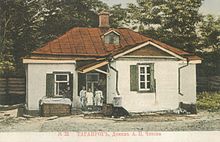Chekhov House
The Chekhov House ( Russian Домик Чехова , Domik Chekhova ) is a state memorial; More precisely, a writers' museum in the southern Russian port city of Taganrog , Chekhovstrasse 69. Anton Chekhov was there on July 17th . / January 29, 1860 greg. born.
Shortly before, in December 1859, Pawel Jegorowitsch Chekhov (1825-1898) had moved in with his wife Evgenija Jakowlewna Chekhova (born Morosowa; 1835-1919) and their sons Alexander (1855-1913) and Nikolai (1858-1889). In March 1861 - on the occasion of the birth of their son Ivan (1861–1922) - the family moved to another apartment.
The building erected in 1859 from mud bricks in Taganroger Alexanderstraße on an area of 30.5 m² was plastered and whitewashed. Shortly after Chekhov's death in the summer of 1904, the street was named after the writer. Garschin's brother, the man of letters and literary critic Yevgeny Garschin (1860–1931), had a memorial plaque put up on Chekhov's 50th birthday in 1910. In 1916 the city of Taganrog bought the house with the intention of establishing a memorial. In 1920 the last tenant moved out. The following year the house was renovated and in 1924 the first exhibition was shown in what is now the Chekhov Museum.
In 1935, Chekhov's sister Maria (1863–1957) and his widow Olga Knipper took part in the celebration of his 75th birthday in their old homeland and brought souvenirs for the museum. For the 150th birthday of Anton Chekhov, the incumbent President Dmitri Medvedev visited the museum in January 2010.
Individual evidence
- ↑ Russian Домик - Domik - the house
- ↑ Russian. The street name
- ↑ Russian Garschin, Evgeni Michailowitsch
- ↑ Russian Chekhova, Marija Pawlowna
Coordinates: 47 ° 12 '25 " N , 38 ° 55' 53" E

